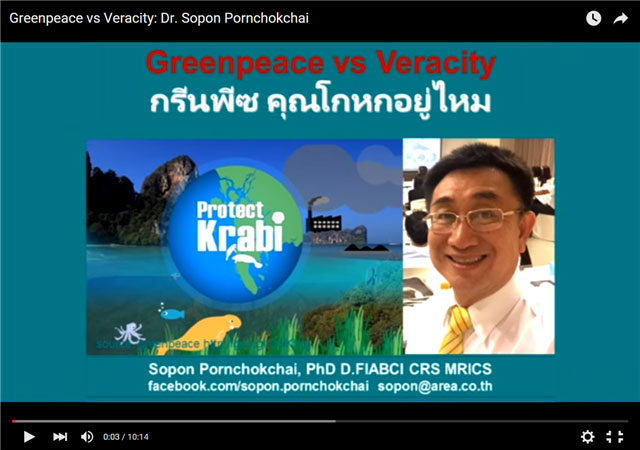 |
|||||||||||||
|
|||||||||||||
Greenpeace vs Veracity
AREA Press Release No. 17/2016: January 13, 2016
Dr.Sopon Pornchokchai, Ph.D. Dip.FIABCI, MRICS
President, Agency for Real Estate Affairs (AREA)
Many question the veracity of Greenpeace. A lot of their movements seem very unusual. However, they are very professional in using emotion and sympathy to win the hearts of others. Their movement seems very dramatic and incites mob rule. We should come to talk with facts and figures.
My name is Sopon Pornchokchai. I am a property appraiser and researcher. I teach in graduate schools and occasionally work for several UN agencies. I earned a PhD in human settlements planning from AIT and had further studies in housing from KULeuven, Belgium and in valuation from LRTI-Lincoln Institute. I run one of the largest property information centres in Asia. Definitely, I love nature and people, particularly the poor. I am the chairman of a foundation to help the homeless. I have observed the movements of Greenpeace on the proposed Krabi coal fired station and believe it contains a number of undocumented and inflammatory opinions. I myself don’t have any hidden agenda. My focus is on the greatest good for the general public.
Greenpeace states that there are 360 deaths from Rayong coal plant each year. Are they lying? Their presentation provides no proof nor source mentioned. I conducted some research and found that in 2003, the proportion of in-patients nationwide caused by cancers, hypertension, heart disease and respiratory systems were 20% and slightly increased to 21% in 2013; whereas, it was only 18% in Rayong in 2003 and slightly decreased to 17% in 2013.
In addition, in 2014 the percentage of deaths caused by cancers, hypertension, heart disease and respiratory systems was only 31% in Rayong which was below the nationwide average of 35%. According to the field survey of dwellers in Map Ta Phut in 2012, only 8 died from all types of pollution in the area. The figures of Greenpeace are an exaggeration!
In the propaganda photo of Greenpeace, it said that there was no future in coal. However, in a comprehensive study with an interdisciplinary approach by the MIT, the bright future of coal was confirmed. The coal uses will increase under any foreseeable scenario because it is cheap and abundant. Nowadays, they use bituminous coal not lignite sources anymore. Less pollution is expected in the future.
The Krabi coal fired plant is located in the south of Thailand. There are some four plants located further south in Malaysia. The Manjung plant is located nearby luxury resorts and communities. It is also by the sea and only 455 kilometres away from Krabi. The Jimah plant which is also located next to a town and there are quite a number of luxury resorts and hotels nearby.
For example, the Avani Sepang Gold Coast Resort is located a few hundred meters from the plant but pollution might not be the problem. According to the reviews of guests, there are no complaints on the existence and the close proximity of the plant. In comparison, Jimah plant is located by the beach; whereas Krabi plant is some 10 kilometers off the beach. In 2009, there were some worries about this plant but now people are confident with the safety of the plant Krabi plant with bituminous coal and better technology will provide safety to the public. That is why the voice against coal can hardly be heard anymore.
KPAR plant is the third example. It is located some 56 kilometers from Kuala Lampur. If it is not safe, this plant should not be located there. The fourth case study is Tanjung Bin Plant, which is located only 9 kilometers from Singapore. The plant and a gigantic sea port is located on a Ramsar site. However, Thai people are fooled into believing that Ramsar sites are something untouchable!
Furthermore, Singapore also has the first coal fired plant. If the technology is not reliable enough, Singapore and Malaysia would not welcome this sort of plant. There was also a study conducted by a professor at the University Technology Malaysia and his colleagues saying that coal fired power plants won’t have significant effects on health.
In addition, an example from the industrialized country is the GKM Mannheim plant in Germany which is safely located on the bank of the Rhine and surrounded by community. On the other hand, even in Cambodia, two plants are located on the beach in Sihanoukville which is the country's most famous resort destination.
In the case of Krabi plant, it was in operation from 1964 to 1995 with lignite which was a lot lower quality coal than bituminous. However, the number of luxury resorts has increased over time. This implies that there is very little environmental effect indeed.
Once during a debate on TV, The Director of Greenpeace Thailand said, their paper against Krabi coal plant was involved with a list of over a thousand people? But it is not documented. This is not a fact. Therefore, this is not a research paper but is just propaganda material published by Greenpeace!?!
From time to time, we saw mobs against the Krabi coal fired power plant. However, they were mostly outsiders. Eventually, representatives of 5,000 dwellers around the proposed plant overwhelmingly came to support the plant’s construction. In a special scoop, it was found that the vast majority of the dwellers agreed to the construction of the coal plant. During 1964 to 1995, the plant used lignite. The dwellers confirmed that there were few negative effects. The proposed plant will use bituminous coal which is of higher quality. Pollution would be a lot less, if any.
The last question to Greenpeace is its transparency. In their financial report which appeared in annual reports, it said “to read the full audited reports, please get in touch with our support care team at supporterservices.ph@greenpeace.org.” I wrote to both their Thailand and Philippines offices, there was no response at all. This makes Greenpeace look unscientific, not creditable, and may have other hidden agendas!
In brief, coal power plants could live with communities. This has been proved worldwide. Coal energy is an answer for the people and environment because it is safe, cheap and abundant. Don't let anyone fool us with fear and false statements. Thank you very much for your attention.
If you would like to discuss my research further please contact me at sopon@area.co.th or call me at +66 2 295 3905. All the best to you and to the world.
------------------
This paper is also published in the Bangkok Post under the title: " Is Greenpeace being flexible with the truth?" at
www.bangkokpost.com/opinion/opinion/821108/is-greenpeace-being-flexible-with-the-truth
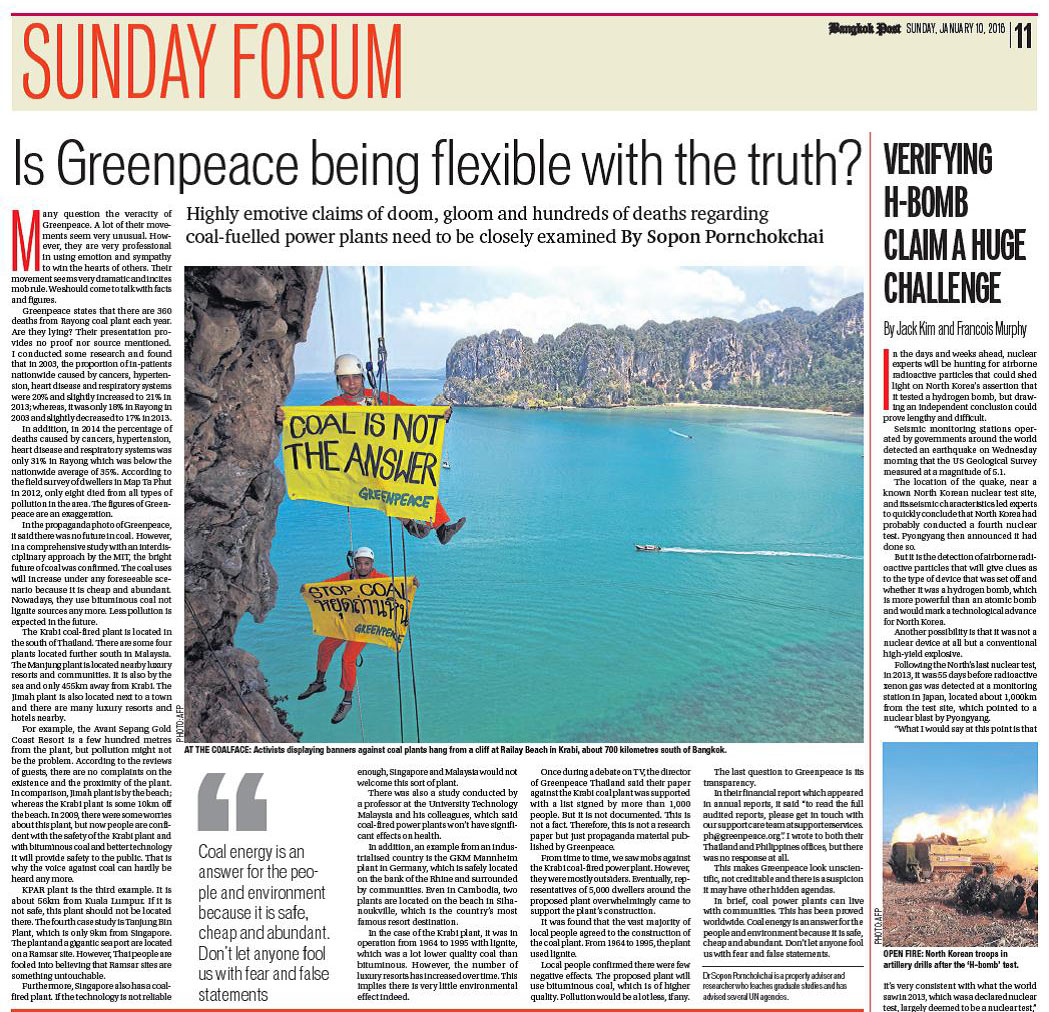
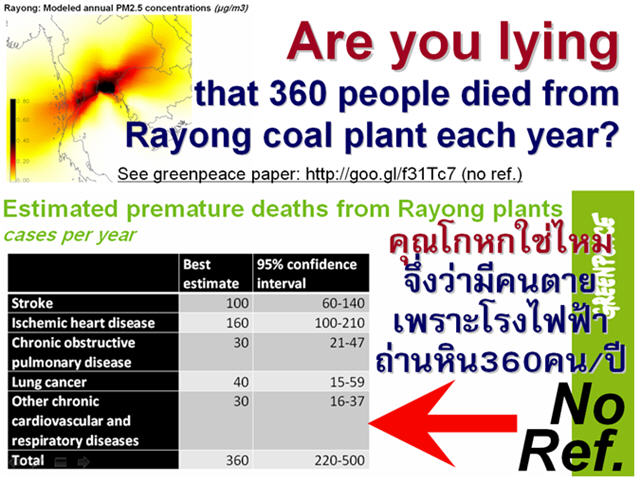
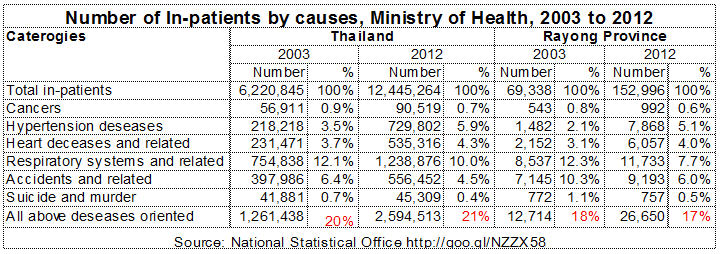
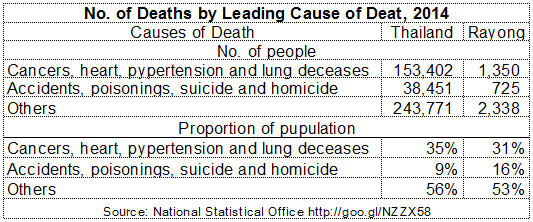
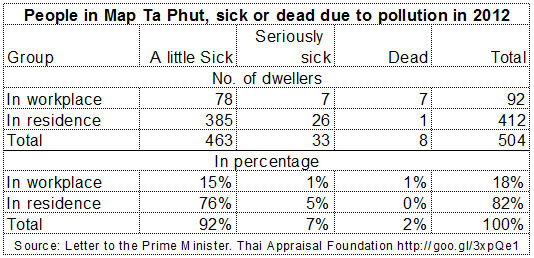
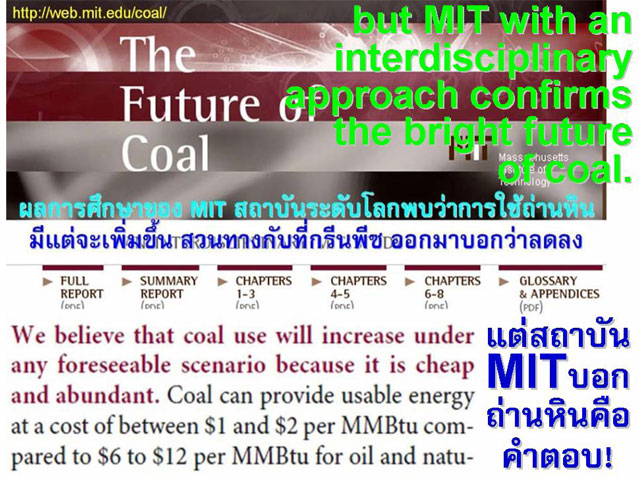
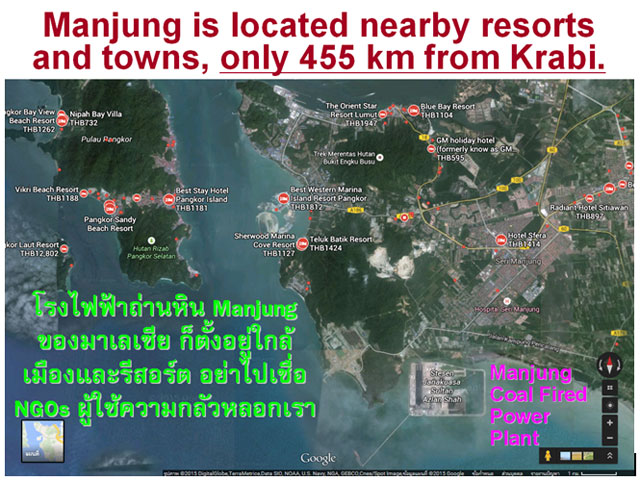
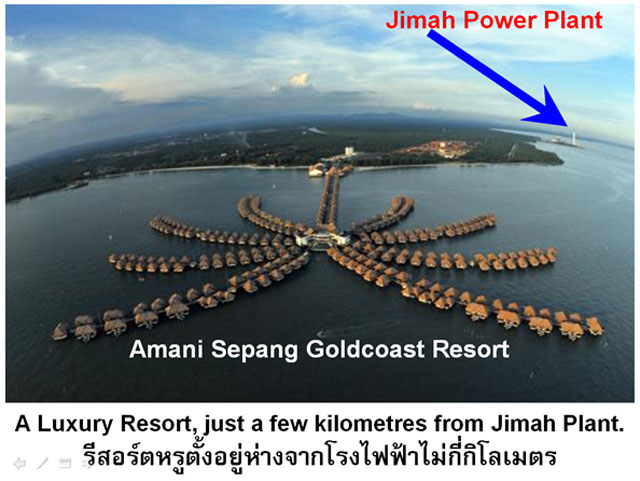
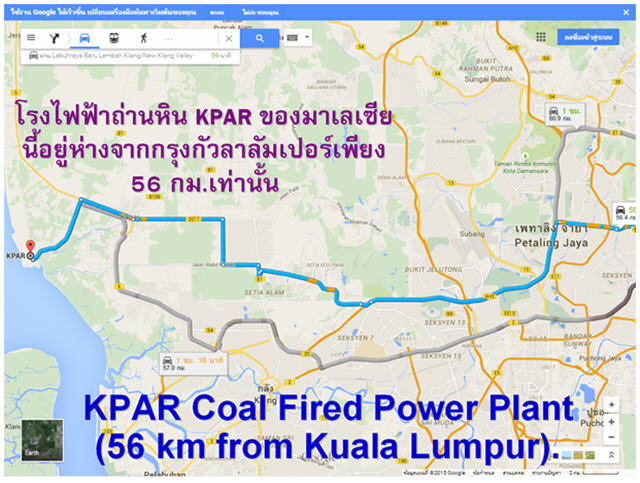
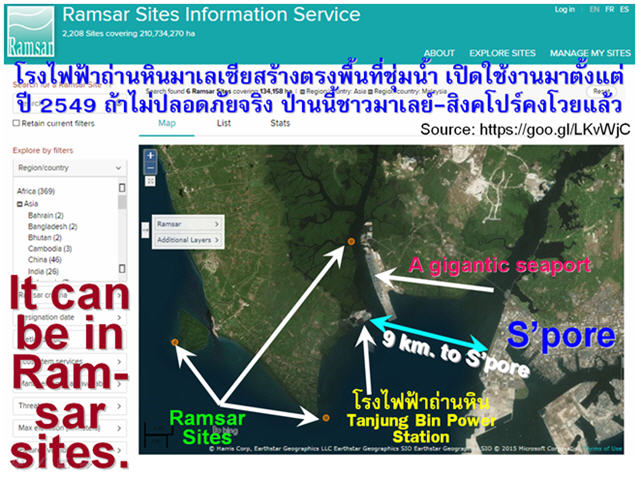
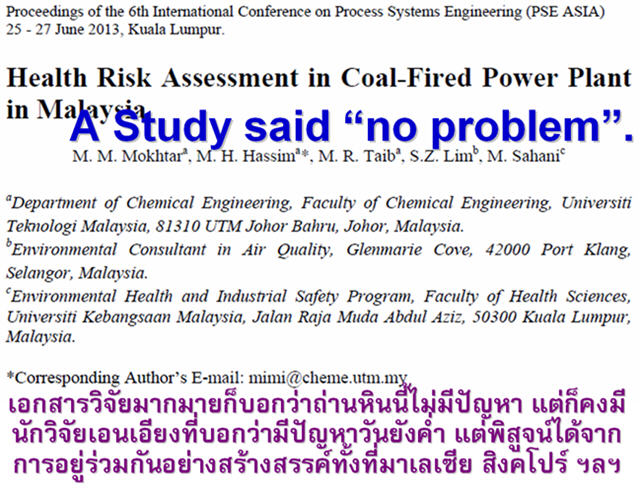
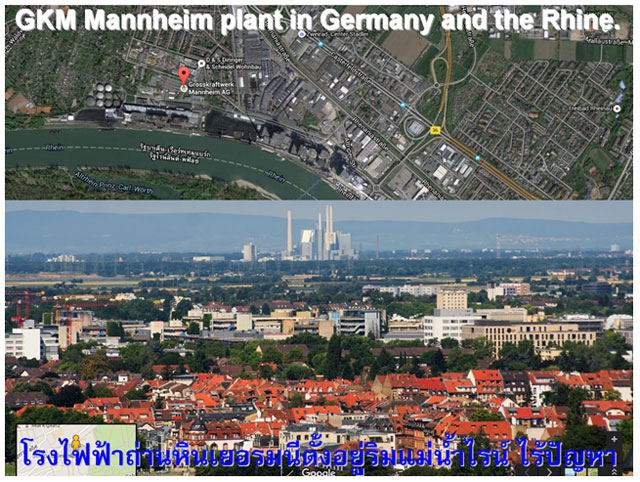
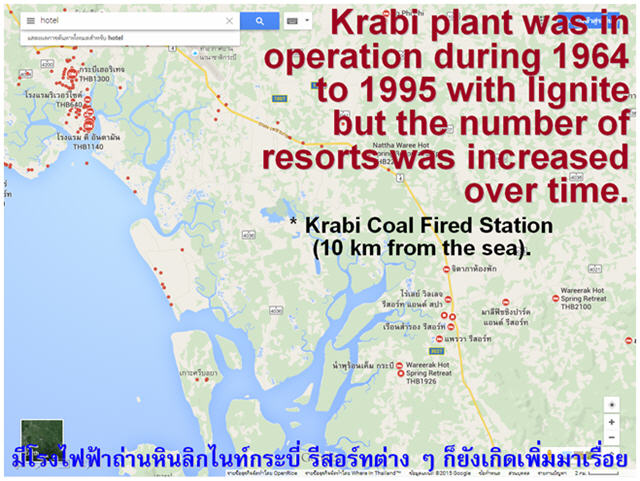
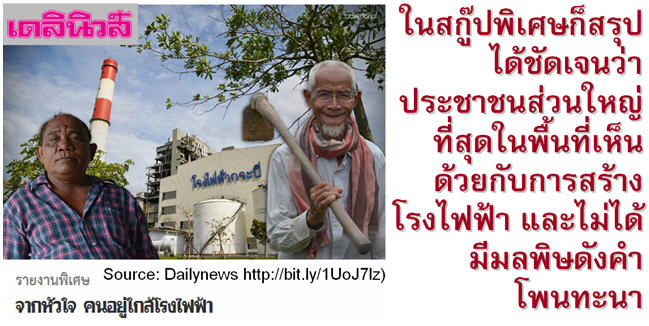
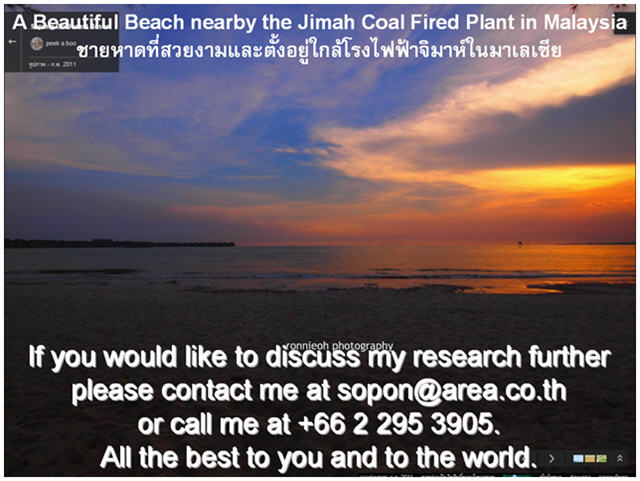
Click to see video: https://www.youtube.com/watch?v=UFNfyjpafCQ
